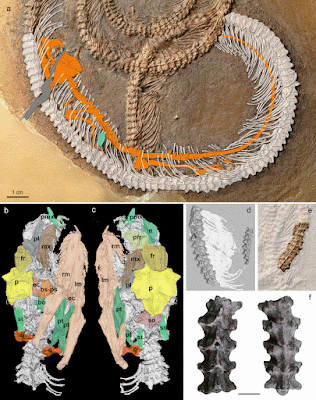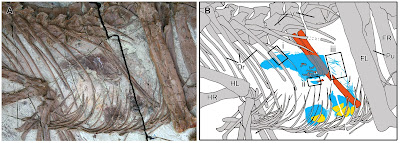Halliday TJD, Cuff AR, Prasad GVR, Thanglemmoi MS, Goswami A, 2016. New record of Egertonia (Phyllodontidae, Elopiformes) from the Late Cretaceous of South India. Papers in Palaeontology. DOI: 10.1002/spp2.1040. Paper link, blog.
The following month the PhD student on the project, Marcela Randau, published the first of her papers on the vertebral column of cats:
Randau M, Goswami A, Hutchinson JR, Cuff AR, Pierce SE. 2016. Cryptic complexity in felid vertebral evolution: shape differentiation and allometry of the axial skeleton. Biological Journal of Linnean Society. DOI: 10.1111/zoj.12403. Paper link, blog.
The early part of they year would also involve various efforts in the field with different cat species as a student and I attempted to gather force plate data (with varying levels of success).
March was a slow publishing month, but April was to be a double whammy with both the papers on cat muscle scaling across the postcrania:
Cuff
AR, Sparkes EL, Randau M,
Pierce SE, Kitchener AR, Gosawmi A, Hutchinson JR, 2016. The scaling of
postcranial muscles in cats (Felidae) I: forelimb, cervical and thoracic
muscles. Journal of Anatomy 229, 128-141. Paper link, blog
Cuff AR, Sparkes EL,Randau M, Pierce SE, Kitchener AR, Gosawmi A, Hutchinson JR, 2016. The scaling of postcranial muscles in cats (Felidae) II: hindlimb and lumbosacral muscles. Journal of Anatomy 229, 142-152. Paper link, blog
Also in April I joined Anjali (as well as Ryan and Carla from the lab) on another trip to Argentina where we joined up with our Argentinian colleagues for continued explorations of the Salta area looking for more fossils. It was a largely unproductive trip in terms of finding many new fossil locales, but we did rule out large areas, revisited the site I discovered previously and found another very promising site. Hopefully Anjali is successful with a large grant that would allow for a longer term exploration of the area with a bigger crew.
April was to be the final month of publishing for a while, but in May my blog passed the 10,000 view mark (or at least as far as blogger's tally count goes) so at least that publishing kept going strong.
At the end of June and into early July I attended the International Congress of Vertebrate Mophology - ICVM. It was another fabulous conference with an abundance of cool science. It made up for not being able to make SVP this year, the first time I haven't attended in 6 years. In years gone by I've heard stories of the attendees who haven't missed on in 40+ years. Guess that won't be me!
The summer would lead to publishing my two most popular blog posts of all times, the first on why extraordinary claims need extraordinary evidence (still surprised there haven't been many comments on it), and the second on some of my favourite figures from palaeontological papers. Both posts got over a thousand hits in their first month which no other posts before or since have matched.
August was a particularly crazy month as I was expecting to be unemployed when September got around. Applications had gone into various places with a fair few rejections before interview, one failed interview (although a friend got the job so can't be too upset about it), and eventually an interview at RVC which was successful in getting me three more months employment as a technician whilst searching for something longer term.
In September I started my technician role, and whilst filling in the paperwork to start was invited to interview for postdoc on John's massive European Research Council (ERC) grant looking at the evolution of pseudosuchians (the crocodile line), and dinosaurs in the Triassic. After a tricky interview and encountering what I now think is a brilliant question on who I would invite to a symposium about the project (although hated it at the time as I blanked on names), I would eventually be offered the position which I gladly accepted. I would be returning to dinosaurs in December, learning some new techniques, and having a couple more years at the RVC.
After a six month hiatus, October would bring the next publication with Marcela again publishing on felid vertebral columns and her kindly writing a blog post for me becoming the first guest blogger on my site.
Randau M, Cuff AR, Hutchinson JR, Pierce SE, Goswami A. 2016. Regional differentiation of felid vertebral column evolution: a study of 3D shape trajectories.Organisms, Diversity & Evolution
DOI 10.1007/s13127-016-0304-4. Paper link, blogNovember would result in my paper on felid brains (in combination with Anjali and our summer student/Imperial Uni undergrad) being accepted, and at present it has a DOI, but we are awaiting proofs before it gets published fully. I was hoping it would be fully online before the end of the year to count as published in 2016 and take my final total up to 6 for the year but it has not made it. At the start of the year I had hoped for 7-10 papers to be published this year. The 2 papers in review (one should be accepted after this round), a few failed projects (like digital image correlation on cat bones) and collaborations that are completed from my end, but not submitted are where I fell short. All of these should add to the expectation of at least 5 more by the end of 2017.
Ultimately December would bring the start of my second postdoctorate on the ERC project (expect many, many posts over the next few years on it), as well as leaving the UK for a much needed 3 week break having not had time off since Easter and feeling exhausted from work.
Across the year I have been practicing what I preach in regards to reviewing papers, with 12 reviews completed for 5 papers across 6 journals (one I got for 2 different journals when it wasn't deemed suitable for the first journal). Somewhat crazily, I have accepted another review across the Christmas holidays, so will be reviewing another one early in 2017.
It has been another good year for me, although maybe not so much politically for science in the UK with Brexit threatening large amounts of funding and collaborations. It shall be interesting to see where things go and I live in the optimistic (and probably vain) hope that it is not the doom and gloom we all fear,
A final amazing figure for the year from an undergraduate research project at Leicester (and a great example of how to get students thinking about science at all levels). I have to say I have nothing to do with the research, but it is a fun studying into whether the satellite phone swallowed by the Spinosaurus in Jurassic Park 3 could really have been heard by the main characters.
 |
| Childs et al., 2016. Dinosaur in-dial-gestion. Journal of Physics Special Topics. Fig 1. A rough model of the path travelled by the sound, with Z-values from the literature. |
Happy New Years and best wishes to all for 2017!






























